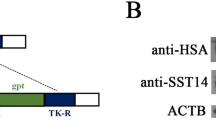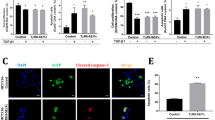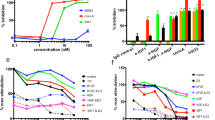Abstract
The insulin-like growth factor I receptor (IGF-IR) plays an essential role in the establishment and maintenance of transformed phenotype of Ewing's sarcoma (ES) cells, and interference with the IGF-IR pathways by a neutralizing antibody causes reversal of the malignant potential of this neoplasm. In this paper, we stably transfected an IGF-IR antisense mRNA expression plasmid in an ES cell line to determine the effectiveness of antisense strategies against the in vitro and in vivo growth of ES cells. Doxorubicin sensitivity of TC-71 cells expressing antisense targeted to IGF-IR mRNA was also examined. Cells carrying antisense IGF-IR had a reduced expression of the receptor, a modest decrease in cell proliferation, a significant increase in anoikis-induced apoptosis, and a severely reduced ability to form colonies in soft agar. Moreover, TC/AS cells showed a marked reduction in their motility. In vivo, when cells carrying antisense IGF-IR were injected subcutaneously in nude mice, tumor formation was delayed and survival increased. Metastatic ability of ES cells was also significantly reduced. Furthermore, TC/AS clones showed a significantly higher sensitivity to doxorubicin — a major drug in the treatment of ES. These results indicate that inhibiting IGF-IR by antisense strategies may be relevant to the clinical treatment of ES patients by reducing the malignant potential of these cells and enhancing the effectiveness of chemotherapy.
This is a preview of subscription content, access via your institution
Access options
Subscribe to this journal
Receive 12 print issues and online access
$259.00 per year
only $21.58 per issue
Buy this article
- Purchase on Springer Link
- Instant access to full article PDF
Prices may be subject to local taxes which are calculated during checkout











Similar content being viewed by others
References
Delattre O, Zucman J, Melot T et al. The Ewing family of tumors — a subgroup of small-round-cell tumors defined by specific chimeric transcripts N Engl J Med 1994 331: 294–299
Ambros IM, Ambros PF, Strehl S, Kovar H, Gadner H, Salzer Kuntschik M . MIC2 is a specific marker for Ewing's sarcoma and peripheral primitive neuroectodermal tumors. Evidence for a common histogenesis of Ewing's sarcoma and peripheral primitive neuroectodermal tumors from MIC2 expression and specific chromosome aberration Cancer 1991 67: 1886–1893
Kovar H, Dworzak M, Strehl S et al. Overexpression of the pseudoautosomal gene MIC2 in Ewing's sarcoma and peripheral primitive neuroectodermal tumor Oncogene 1990 45: 1067–1070
Campanacci M . Bone and Soft Tissue Tumors 2nd ed Wien: Springer-Verlag 1999
Bacci G, Toni A, Avella M et al. Long-term results in 144 localized Ewing's sarcoma patients treated with combined therapy Cancer 1988 63: 1477–1486
Burgert EO, Nesbit ME, Garnsey LA et al. Multimodal therapy for the management of nonpelvic, localized Ewing's sarcoma of bone: intergroup study IESS-II J Clin Oncol 1990 8: 1514–1524
Paulussen M, Ahrens S, Craft AW et al. Ewing's tumors with primary lung metastases: survival analysis of 114 (European Intergroup) cooperative Ewing's sarcoma studies patients J Clin Oncol 1998 16: 3044–3052
Bacci G, Picci P, Ferrari S et al. Neoadjuvant chemotherapy for Ewing's sarcoma of bone. No benefit observed after adding iphosphamide and etoposide to vincristine, actinomycin, cyclophosphamide, and doxorubicin in the maintenance phase. Results of two sequential studies Cancer 1998 6: 1174–1183
Craft A, Cotterill S, Malcolm A et al. Ifosfamide-containing chemotherapy in Ewing's sarcoma: the Second United Kingdom Children's Cancer Study Group and the Medical Research Council Ewing's Tumor Study J Clin Oncol 1998 16: 3628–3633
Yee D, Favoni RE, Lebovic GS et al. Insulin-like growth factor I expression by tumors of neuroectodermal origin with the t(11;22) chromosomal translocation. A potential autocrine growth factor J Clin Invest 1990 86: 1806–1814
Scotlandi K, Benini S, Sarti M et al. Insulin-like growth factor I receptor–mediated circuit in Ewing's sarcoma/peripheral neuroectodermal tumor: a possible therapeutic target Cancer Res 1996 56: 4570–4574
Toretsky JA, Kalebic T, Blakesley V, LeRoith D, Helman LJ . The insulin-like growth factor-I receptor is required for EWS/FLI-1 transformation of fibroblasts J Biol Chem 1997 272: 30822–30827
Scotlandi K, Benini S, Nanni P et al. Blockage of insulin-like growth factor-I receptor inhibits the growth of Ewing's sarcoma in athymic mice Cancer Res 1998 58: 4127–4131
Resnicoff M, Coppola D, Sell C, Rubin R, Ferrone S, Baserga R . Growth inhibition of human melanoma cells in nude mice by antisense strategies to the type 1 insulin-like growth factor receptor Cancer Res 1994 54: 4848–4850
Resnicoff M, Sell C, Rubini M et al. Rat glioblastoma cells expressing an antisense RNA to the insulin-like growth factor-1 (IGF-1) receptors are nontumorigenic and induce regression of wild-type tumors Cancer Res 1994 54: 2218–2222
Heid CA, Stevens J, Livak KJ, Williams PM . Real time quantitative PCR Genome Res 1996 6: 986–994
Gibson UE, Heid CA, Williams PM . A novel method for real time quantitative RT-PCR Genome Res 1996 6: 995–1001
Bradford MM . A rapid and sensitive method for the quantitation of microgram quantities of proteins utilizing the principle of protein–dye binding Anal Biochem 1976 72: 248–254
Folkman J, Moscona A . Role of cell shape in growth control Nature 1978 273: 345–349
Valentinis B, Reiss K, Baserga R . Insulin-like growth factor-I–mediated survival from anoikis: role of cell aggregation and focal adhesion kinase J Cell Physiol 1998 176: 648–657
Valentinis B, Morrione A, Peruzzi F, Prisco M, Reiss K, Baserga R . Anti-apoptotic signaling of the IGF-I receptor in fibroblasts following loss of matrix adhesion Oncogene 1999 18: 1827–1836
Aaronson TA, Todaro GJ . Basis for the acquisition of malignant potential by mouse cells cultivated in vitro Science 1968 162: 1024–1026
Scotlandi K, Benini S, Manara MC et al. Murine model for skeletal metastases of Ewing's sarcoma J Orthop Res 2000 18: 959–966
van Valen F, Winkelmann W, Jurgens H . Type I and type II insulin-like growth factor receptors and their function in human Ewing's sarcoma cells J Cancer Res Clin Oncol 1992 118: 269–275
De Alava E, Kawai A, Healey JH et al. EWS–FLI1 fusion transcript structure is an independent determinant of prognosis in Ewing's sarcoma J Clin Oncol 1998 16: 1248–1255
De Alava E, Panizo A, Antonescu CR et al. Association of EWS/FLI1 type 1 fusion with lower proliferative rate in Ewing's sarcoma Am J Pathol 2000 156: 849–855
Toretsky JA, Thakar M, Eskenazi AE, Frantz CN . Phosphoinositide 3-hydroxide kinase blockade enhances apoptosis intheEwing's sarcoma family of tumors Cancer Res 1999 59: 5745–5750
Long L, Rubin R, Baserga R, Brodt P . Loss of the metastatic phenotype in murine carcinoma cells expressing an antisense RNA to the insulin-like growth factor receptor Cancer Res 1995 55: 1006–1009
Lee C-T, Wu S, Gabrilovich D et al. Antitumor effects of an adenovirus expressing antisense insulin-like growth factor I receptor on human lung cancer cell lines Cancer Res 1996 56: 3038–3041
Burfeind P, Chernicky CL, Rininsland F, Ilan J, Ilan J . Antisense RNA to the type I insulin-like growth factor receptor suppresses tumor growth and prevents invasion by rat prostate cancer cells in vivo Proc Natl Acad Sci USA 1996 93: 7263–7268
Nakamura K, Hongo A, Kodama J, Miyagi Y, Yoshinouchi M, Kudo T . Down-regulation of the insulin-like growth factor I receptor by antisense RNA can reverse the transformed phenotype of human cervical cancer cell lines Cancer Res 2000 60: 760–765
Chernicky CL, Yi L, Tan H, Gan SU, Ilan J . Treatment of human breast cancer cells with antisense RNA to the type I insulin-like growth factor receptor inhibits cell growth, suppresses tumorigenesis, alters the metastatic potential, and prolongs survival in vivo Cancer Gene Ther 2000 7: 384–395
Baserga R, Hongo A, Rubini M, Prisco M, Valentinis B . The IGF-I receptor in cell growth, transformation and apoptosis Biochim Biophys Acta 1997 1332: F105–F126
Eastman A . Activation of programmed cell death by anticancer agents: cisplatin as a model system Cancer Cells 1990 2: 275–280
Waldman T, Zhang Y, Dillehay L et al. Cell-cycle arrest versus cell death in cancer therapy Nat Med 1997 3: 1034–1036
Sell C, Baserga R, Rubin R . Insulin-like growth factor I (IGF-I) and the IGF-I receptor prevent etoposide-induced apoptosis Cancer Res 1995 55: 303–306
Turner BC, Haffty BG, Narayanan L et al. Insulin-like growth factor 1 receptor overexpression mediates cellular resistance and local breast cancer recurrence after lumpectomy and radiation Cancer Res 1997 57: 3079–3083
Nakamura S, Watanabe H, Miura M, Sasaki T . Effect of the insulin-like growth factor 1 receptor on ionizing radiation-induced cell death in mouse embryo fibroblast Exp Cell Res 1997 235: 287–294
Dunn SE, Hardman RA, Kari FW, Barrett CJ . Insulin-like growth factor 1 (IGF-I) alters drug sensitivity of HBL 100 human breast cancer cells by inhibition of apoptosis induced by diverse anticancer drugs Cancer Res 1997 57: 2687–2693
Acknowledgements
This work was supported by grants from the Italian Association for Cancer Research, the Italian Ministry for University and Research, and the Rizzoli Institute. VC is the recipient of a Fellowship from the Italian Foundation for Cancer Research. We thank Renato Baserga (Kimmel Cancer Center, Thomas Jefferson University) for kindly providing us with the plasmid expressing antisense sequences to IGF-IR RNA.
Author information
Authors and Affiliations
Corresponding author
Rights and permissions
About this article
Cite this article
Scotlandi, K., Maini, C., Manara, M. et al. Effectiveness of insulin-like growth factor I receptor antisense strategy against Ewing's sarcoma cells. Cancer Gene Ther 9, 296–307 (2002). https://doi.org/10.1038/sj.cgt.7700442
Received:
Published:
Issue Date:
DOI: https://doi.org/10.1038/sj.cgt.7700442
Keywords
This article is cited by
-
Tumor levels of the mediators of ErbB2-driven anoikis resistance correlate with breast cancer relapse in patients receiving trastuzumab-based therapies
Breast Cancer Research and Treatment (2021)
-
Targeting of AKT-Signaling Pathway Potentiates the Anti-cancer Efficacy of Doxorubicin in A673 Ewing Sarcoma Cell Line
BioNanoScience (2021)
-
ErbB2-dependent downregulation of a pro-apoptotic protein Perp is required for oncogenic transformation of breast epithelial cells
Oncogene (2016)
-
Anoikis of colon carcinoma cells triggered by β-catenin loss can be enhanced by tumor necrosis factor receptor 1 antagonists
Oncogene (2015)
-
Prognostic and therapeutic relevance of the IGF pathway in Ewing’s sarcoma patients
Targeted Oncology (2013)



